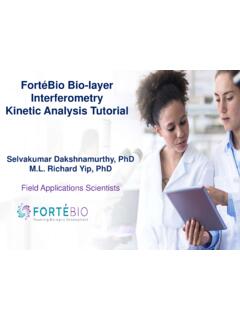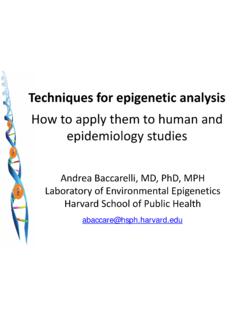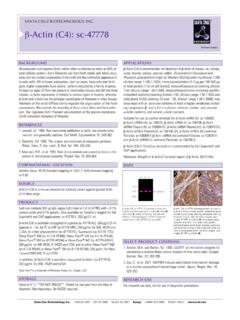Transcription of What is a sandwich ELISA? - Assay Genie
1 sandwich ELISA | ELISA Genie Figure 1: A schematic of a sandwich ELISA, whereby the capture antibody and detection antibody have bound to the protein of interest. What is a sandwich ELISA? sandwich ELISA (Enzyme- linked immunosorbent Assay ) is a antibody based technique that allows researchers to quantify the amount of protein, hormone or analyte of interest in a sample. Capture and detection antibodies bind to non- overlapping epitopes on the protein to sandwich the protein, hence the name, sandwich ELISA. Following the addition of the detection antibody, a chemical substrate is added (such as TMB) to produce a colorimetric signal that can be read by an ELISA plate reader.
2 sandwich ELISA antibodies Antibodies used to create a sandwich ELISA can be either polyclonal or monoclonal antibodies depending on the specificity, sensitivity and analyte being detected. > Polyclonal antibodies Polyclonal antibodies are often used to pull down as much analyte as possible in a sample. Polyclonal antibodies can bind to multiple facets of an epitope therefore, provide an increased capture opportunity for detecting proteins of interest. > Monoclonal antibodies Monoclonal antibodies allow researchers to pull down a single antigen. Therefore, allow researchers to distinguish between subtle differences in proteins.
3 Monoclonal antibodies also provide increased consistency in data versus polyclonal antibodies. sandwich ELISA | ELISA Genie Advantages of a sandwich ELISA. Advantage Description No sample sandwich ELISA assays allow for the measure of proteins/analytes in purification complex samples without the need for purification. required High Since capture and detection antibodies are used, a sandwich ELISA. specificity Assay has increased sensitivity versus a direct or indirect ELISA Assay . Versus other EIA methods such as a Western Blot, the sandwich Quantification ELISA Assay allows researchers to quantify the amount of protein in a sample.
4 sandwich ELISA Protocols sandwich ELISA assays help researchers quantify proteins of interest in samples such as serum, plasma, cell supernatant, tissue and other biological samples. sandwich ELISA kits can be purchased in two formats, either as a pre-coated ELISA. plate, whereby the capture antibody has already be coated on the polystyrene ELISA. plate, or antibody pairs can be purchased to develop your own ELISA sandwich Assay . Below we describe both protocols. Sample preparation & collection A range of sample types can be used to measure protein/analyte levels by sandwich ELISA.
5 According to best practices, extract protein & perform the experiment as soon as possible after sample collection. Alternatively, store the extracts at the designated temperature (-20 C/-80 C) and for optimal results avoid repeated freeze-thaw cycles. Serum: If using serum separator tubes, allow samples to clot for 30 minutes at room temperature. Centrifuge for 10 minutes at 1,000x g. Collect the serum fraction and Assay promptly or aliquot and store the samples at -80 C. Avoid multiple freeze-thaw cycles. If serum separator tubes are not being used, allow samples to clot overnight at 2- 8 C.
6 Centrifuge for 10 minutes at 1,000x g. Remove serum and Assay promptly or aliquot and store the samples at -80 C. Avoid multiple freeze-thaw cycles. Plasma: Collect plasma using EDTA or heparin as an anticoagulant. Centrifuge samples at 4 C for 15 mins at 1000 g within 30 mins of collection. Collect the sandwich ELISA | ELISA Genie plasma fraction and Assay promptly or aliquot and store the samples at -80 C. Avoid multiple freeze-thaw cycles. Note: Over haemolysed samples are not suitable for use. For further information on different sample types, please see our sample collection guide.
7 sandwich ELISA (pre-coated) protocol step-by-step sandwich ELISA | ELISA Genie Figure 3: sandwich ELISA protocol for a pre-coated ELISA plate. Step by step schematic for the steps involved in a sandwich ELISA Assay . Firstly, prepare standards, followed by the addition of samples to the ELISA plate & incubate. Once incubated, wash the plate followed by the addition of labelled antibody & incubate. Following incubation, wash the plate and add the SABC working solution. Wash the plate and add the TMB substrate, followed by an incubation. Finally add stop solution and measure. Step Procedure Set standard, test sample and control (zero) wells on the pre-coated plate respectively, and then, record their positions.
8 It is recommended to measure each standard and 1. sample in duplicate. Wash plate 2 times before adding standard, sample and control (zero) wells! 2. Aliquot standard solutions into the standard wells. 3. Add ml of Sample / Standard dilution buffer into the control (zero) well. Add ml of properly diluted sample ( Human serum, plasma, tissue homogenates and 4. other biological fluids.) into test sample wells. 5. Seal the plate with a cover and incubate at 37 C for 90 min. Remove the cover and discard the plate content, clap the plate on the absorbent filter 6. papers or other absorbent material.
9 Do NOT let the wells completely dry at any time. Wash plate X2. Add ml of Biotin- detection antibody working solution into the above wells (standard, 7. test sample & zero wells). Add the solution at the bottom of each well without touching the side wall. 8. Seal the plate with a cover and incubate at 37 C for 60 min. Remove the cover, and wash plate 3 times with Wash buffer. Let wash buffer rest in 9. wells for 1 min between each wash. Add ml of SABC working solution into each well, cover the plate and incubate at 10. 37 C for 30 min. Remove the cover and wash plate 5 times with Wash buffer, and each time let the wash 11.
10 Buffer stay in the wells for 1-2 min. Add 90 l of TMB substrate into each well, cover the plate and incubate at 37 C in dark 12. within 15-30 min. (Note: This incubation time is for reference use only, the optimal time should be determined by end user.) And the shades of blue can be seen in the first 3-4. sandwich ELISA | ELISA Genie Step Procedure wells (with most concentrated standard solutions), the other wells show no obvious color. Add 50 l of Stop solution into each well and mix thoroughly. The color changes into 13. yellow immediately. Read the absorbance at 450 nm in a microplate reader immediately after adding 14.






